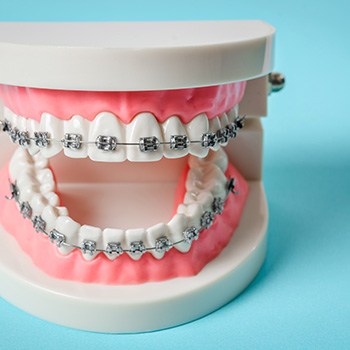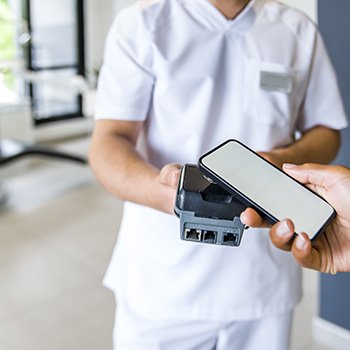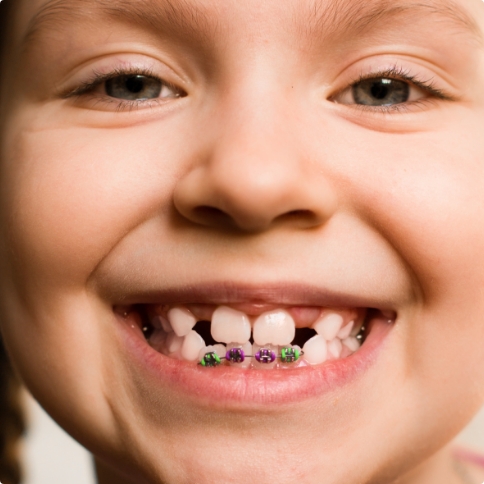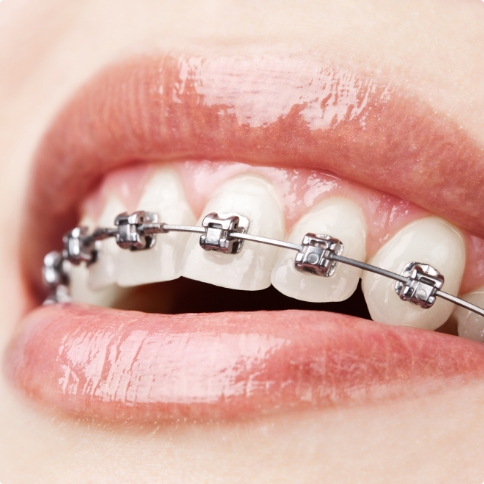You probably know that several orthodontic systems can straighten teeth. There’s Invisalign®, which uses clear plastic aligners to realign your smile. There is also a system that looks a lot like traditional metal braces but uses tooth-colored brackets and wires. But if you want the most reliable system, then nothing can match traditional orthodontics. These braces are based on years and years of research and trial. For traditional braces in Weatherford, contact Dr. Decker at Cosmetic & Family Dentistry of Weatherford.
Why Choose Cosmetic & Family Dentistry of Weatherford for Traditional Braces?
- Dentist with Advanced Ortho Training
- Reliable Results Using Enhanced Diagnostic Imaging
- Your Dental Insurance Is Welcome
What Can Traditional Orthodontics Fix?
Traditional braces are the most often recommended treatment style for just about any type of alignment problem. Whether your child’s smile or yours is affected by overcrowding or rotated teeth, gaps between teeth, or an overbite, crossbite, or underbite, standard metal brackets and wires can correct one or a combination of these concerns. The treatment time depends on the specific set of circumstances that each case presents, but most children and adults wear braces for no more than 24 months.
The Process of Traditional Braces
Traditional braces consist of metal brackets that are adhesively bonded to the facial side of teeth. Arch wires clip into those brackets and elastic bands hold the wires in place. To keep the wires from shifting, metal bands are looped around molars to hold them in place.
About every six to eight weeks, you’ll come to see your dentist in Weatherford to have your braces adjusted. As you progress through treatment, you will gradually begin to see your smile get closer and closer to perfect alignment.
Should Your Child Have Braces?
According to the American Association of Orthodontists, children should be evaluated for braces by the time they are seven years old. By this age, their permanent front teeth and their first molars have all erupted. Dr. Decker will examine your child’s dentition to see if there are any existing or developing eruption problems. She will also check to see if there are problems involving the growth of their jaw, protruding teeth, or crowded teeth.
After an initial evaluation, Dr. Decker will talk to you about whether or not early orthodontic intervention could be helpful to your child.
Understanding the Cost of Traditional Braces
While you may need metal braces, their price could make you hesitate a bit. That’s a fair worry – orthodontic work can get rather pricey at times. Even so, the cost of traditional braces varies by the patient; you should consult Dr. Decker for an exact estimate. Our team will also work to make your care more affordable, laying out its pricing factors, payment options, etc. For further details, please keep reading or call us soon!

Factors That Affect the Cost of Traditional Braces
Dr. Decker will give you a quick oral exam at your consultation. That way, they can assess factors that impact your metal braces’ final cost. These include:
- Your Age – Adult teeth are more firmly set than those from childhood and adolescence. Since they take longer to move, your treatment may cost slightly more.
- Treatment Length – The longer you wear braces, the more they’ll cost. You’ll need more routine checkups, adjustments, supplies, etc.
- Need for Accessories – Aside from braces, you may need supplies like elastics, space maintainers, or retainers. These items will add to your treatment price.
- Compliance with Care – If you need to wear certain items with your braces but don’t, your teeth won’t move as planned. Your treatment will then take longer.

Professional Braces vs. “DIY” Braces: Which Costs More?
It may seem like “DIY” braces are cost-effective at first; they have a lower upfront price. Even so, the truth is that professional braces save you more money in the long run.
Firstly, DIY braces don’t deliver good long-term results. While they may move your teeth more quickly, their effects are less likely to last more than a year or so. Your teeth will be at great risk of returning to their previous positions after a while.
You should also note that “DIY” braces often lead to more spending than metal ones. If they cause any harm to your smile or mouth, you’ll need to visit a dentist or orthodontist to correct the damage. This follow-up work would be costly and would defeat the purpose of DIY braces. In fact, you may end up having to wear traditional braces anyway.

Does Dental Insurance Cover Braces?
While dental insurance doesn’t often cover orthodontic work, it’s more likely to offer coverage for metal braces than clear aligners. Your odds of getting benefits also rise if the braces are for medical reasons. Plus, some plans fully cover braces for patients under 18.
Assuming you qualify, you can expect up to 50% coverage. Our team will also help you maximize your benefits! If you have an HAS or FSA account, you can even use either one to pay for care partially.

Options for Making Braces Affordable
If you lack insurance, don’t worry; you can still make braces affordable. All you need to do is try one of our practice’s helpful payment options! Given the right one, you can wear metal braces without “breaking the bank.”
For example, consider our CareCredit Financing service. This option lets you pay for braces in small, monthly installments, each with little or no interest. That means you could gradually cover the cost instead of doing so all at once.
Here at Cosmetic & Family Dentistry of Weatherford, we want your braces to be budget-friendly. Learn how to finance them by seeing us!
Traditional Braces FAQs
You're never too old to get braces! Orthodontic treatment is effective at any age as long as your teeth and gums are healthy. Many adults opt for braces to improve their smile, correct bite issues, or address problems like overcrowding or gaps. Advances in orthodontics, such as clear aligners or ceramic braces, offer more discreet options that appeal to adults. However, orthodontic treatment for adults can sometimes take longer than it would for children or teens due to factors like bone density and teeth movement speed. Coming to us for a consultation can help determine the best approach for your specific needs, regardless of your age.
Yes, you can get traditional braces on just your top or bottom teeth, a treatment option known as single-arch orthodontics. However, this approach isn't suitable for everyone. We usually recommend treating both arches to ensure proper alignment and bite correction, as focusing on just one arch can sometimes lead to issues like an improper bite or misalignment between the upper and lower teeth. If you're considering braces for only the top or bottom teeth, it's important to consult with us so that we can assess your specific case and determine if single-arch treatment will be effective and safe for you.
Chewing gum with traditional braces is generally not recommended. Gum can easily get stuck in the brackets and wires, making it difficult to clean and potentially damaging the braces. Sticky or sugary gum can increase the risk of cavities, plaque buildup, and can even cause wires to bend or brackets to loosen. However, if you're really craving gum, it may be possible to chew some sugar-free gum in moderation, as it doesn't stick as much and can help with dry mouth. Always consult with us before chewing gum, as we can provide guidance based on your specific treatment plan and progress.
Yes, you can drink coffee with traditional braces, but there are a few considerations to keep in mind. Coffee is acidic and can stain both your teeth and the brackets of your braces, leading to discoloration. Additionally, hot beverages like coffee can soften the adhesive that holds your brackets in place, potentially causing them to loosen. If you drink coffee, it's a good idea to rinse your mouth with water afterward and brush your teeth as soon as possible to minimize staining and prevent plaque buildup. Drinking coffee through a straw can also help reduce contact with your teeth, protecting both your braces and your smile.
I Need a Checkup & Cleaning I Need Help with a Lip and/or Tongue-Tie I am Worried About Gum Disease I Have a Cavity or Broken Tooth I am Missing One or More Teeth I Want to Enhance My Smile I Want a Straighter Smile I Have Jaw Pain I am Scared of the Dentist I'm Having Trouble Sleeping I Have a Dental Emergency View Our Services




